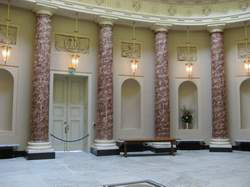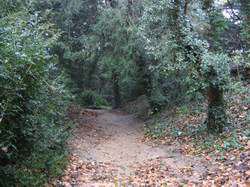Abandoned Communities ..... Stowe
By the middle of the eighteenth century Stowe was famous throughout Europe for its house and landscaped gardens. They were eulogised in many poems, but as none of those poems mentions the deserted village I have not reproduced any of them in the Poetry section of this website.
The house and gardens retain their splendour today. Since 1923 the house has been occupied by Stowe School, while large parts of the gardens and parks are now in the care of the National Trust. A current project by the National Trust is to renovate the deer park, north of the house.
The section of the National Trust website on Stowe is at this address, or you can visit the website of Stowe School. Photographs of the gardens abound on the internet, but a website that can be strongly recommended is one by John Tatter. If, like me, you have a fondness for the presentation style of Jonathan Meades, then go to YouTube and watch Meades stroll around the grounds of Stowe.
I went to Stowe in December 2007, when people were still talking about the recent visit of Queen Elizabeth II and Prince Philip. Gary Marshall, Regional Archaeologist for the National Trust, was kind enough to show me around some of the rooms of the house and the Elysian Fields, the part of the gardens close to the church where the village must have been. As a special bonus we had lunch together in the school dining room, once the State Dining Room.
I returned to Stowe two days later to explore the gardens more thoroughly, spend some time at the church, and take some photographs. On that occasion the weather was lousy. The only people I passed were two very wet schoolboys. I will go again on a day when the sun is shining.
Earthworks can be seen where the village of Lamport once stood, at OS SP684375. You can reach it on a public footpath, starting either from the eastern border of the Stowe estate or from the road running north west from Maids Moreton, just beyond Stowe Castle Farm.
The earthworks of Lamport have been surveyed by Graham Brown, whose report has been published by Heritage England.
There is uncertainty about the location of Boycott. However, on the website of the Whittlewood Project, mentioned earlier, it has been argued that it may have occupied land around the present Boycott Farm, at OS SP664361.
If you go to Boycott Farm make sure you call in at the farm shop, where a very wide range of enticing products are on sale.
The house and gardens retain their splendour today. Since 1923 the house has been occupied by Stowe School, while large parts of the gardens and parks are now in the care of the National Trust. A current project by the National Trust is to renovate the deer park, north of the house.
The section of the National Trust website on Stowe is at this address, or you can visit the website of Stowe School. Photographs of the gardens abound on the internet, but a website that can be strongly recommended is one by John Tatter. If, like me, you have a fondness for the presentation style of Jonathan Meades, then go to YouTube and watch Meades stroll around the grounds of Stowe.
I went to Stowe in December 2007, when people were still talking about the recent visit of Queen Elizabeth II and Prince Philip. Gary Marshall, Regional Archaeologist for the National Trust, was kind enough to show me around some of the rooms of the house and the Elysian Fields, the part of the gardens close to the church where the village must have been. As a special bonus we had lunch together in the school dining room, once the State Dining Room.
I returned to Stowe two days later to explore the gardens more thoroughly, spend some time at the church, and take some photographs. On that occasion the weather was lousy. The only people I passed were two very wet schoolboys. I will go again on a day when the sun is shining.
Earthworks can be seen where the village of Lamport once stood, at OS SP684375. You can reach it on a public footpath, starting either from the eastern border of the Stowe estate or from the road running north west from Maids Moreton, just beyond Stowe Castle Farm.
The earthworks of Lamport have been surveyed by Graham Brown, whose report has been published by Heritage England.
There is uncertainty about the location of Boycott. However, on the website of the Whittlewood Project, mentioned earlier, it has been argued that it may have occupied land around the present Boycott Farm, at OS SP664361.
If you go to Boycott Farm make sure you call in at the farm shop, where a very wide range of enticing products are on sale.
Five
The Marble Saloon
Footpath through the Elysian Fields
The south front of Stowe House, taken from where the village of Stowe would have been
The site of Lamport village
The shop at Boycott Farm.
By this time I was quite pleased to get inside.
By this time I was quite pleased to get inside.




